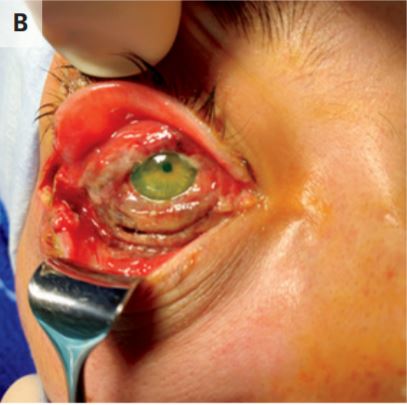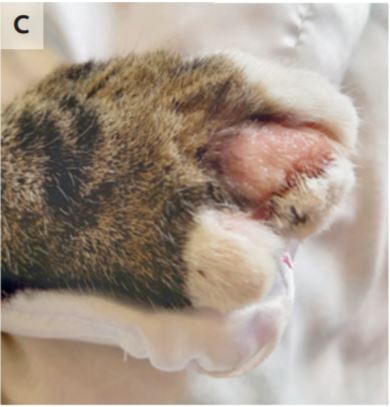Woman gets rare cowpox infection from her pet cat
The infection, in her right eye, threatened to take her vision.

A U.K. woman developed a severe eye infection thanks to a rare virus — cowpox, a cousin of smallpox, which she contracted from her pet cat.
The 28-year-old woman went to the emergency room after she experienced eye irritation, along with redness and discharge in her right eye, which had lasted for five days, according to the report, published June 5 in The New England Journal of Medicine. She received a slew of antibiotics and antiviral drugs used to treat common eye infections, but nothing seemed to work. Her symptoms were getting worse — she had developed orbital cellulitis, or an infection of the fat and muscles around the eye; and this infection was causing the tissue in her eye to necrotize, or die. Her doctors worried she would lose her vision.
"Our concern was that the infection would permanently damage her vision, or possibly spread beyond the orbit [eye socket]," said Dr. Miles Kiernan, an ophthalmologist at Royal Free Hospital in London, who treated the patient.
Related: 11 ways your beloved pet may make you sick

A clue to the patient's illness came from her pet cat. The patient reported that two weeks earlier, her cat had developed lesions on its paws and head, the report said.
Samples from the cat's lesions and the woman's eye both tested positive for orthopoxvirus — the family of viruses that includes the smallpox virus (variola virus), cowpox virus and monkeypox virus. Further genetic sequencing of the woman's sample confirmed she was infected with cowpox.
Cowpox can infect multiple animal species, including cows, cats and humans. It's closely related to the vaccinia virus, which is used in the smallpox vaccine. (The physician Edward Jennor famously used cowpox to create the world's first vaccine, against smallpox, in 1796, after he noticed that dairy farmers who contracted cowpox were immune to smallpox.) Today, cowpox is rare in cattle, and the main reservoir is rodents, according to the Merck Veterinary Manual. Cats can become infected when they kill rodents carrying cowpox, but transmission from cats to people is rare, Kiernan told Live Science.
Sign up for the Live Science daily newsletter now
Get the world’s most fascinating discoveries delivered straight to your inbox.
Humans can become infected with cowpox through contact with cowpox lesions on cats' skin, but the virus isn't very contagious between people and cats, and the risk of infection can be greatly reduced with hygiene measures such as wearing gloves when handling infected cases, according to VCA Animal Hospitals. The virus has not been detected in cats in the United States, according to Merck.
Doctor's suspect the woman's eye became infected when she petted her cat and then touched or rubbed her eyes, Kiernan said.

Kiernan added that he and his colleagues have never seen a case of cowpox infection of the eye before, and few cases have ever been reported in the medical literature.
But those cases that have been reported have been difficult to treat, he said. In the current case, Kiernan and colleagues received input from leading viologists and infectious disease specialists at their hospital. They recommended treatment with tecovirimat (TPOXX), an antiviral drug that targets orthopoxvirus and was approved by the U.S. Food and Drug Administration for treating smallpox in 2018.
There was one problem — tecovirimat isn't available in the U.K. So Kiernan and colleagues needed to obtain it from the U.S. Strategic National Stockpile, which contains some 2 million doses of tecovirimat in case of a bioterror attack with smallpox, he said. (Smallpox was eradicated from the world in 1980, thanks to a global vaccination campaign, but governments worry that the smallpox virus could be used as a bioweapon, Live Science previously reported.)
The patient received a prolonged course of tecovirimat and required surgery to remove dead tissue from around her eye, the report said. The treatment worked to clear her infection. Six months later, the patient had 20/20 vision in her right eye, although she had some dropping of the upper eyelid, and had some trouble with eye movements, the report said.
The case highlights the risk of zoonotic infections, or those that jump from animal to people; such spillover events have gained attention in light of the COVID-19 pandemic, which likely originated in a wild animal.
Although smallpox has been eradicated, "orthopoxviruses remained in certain parts of the world, including cowpox in Europe, and monkeypox in central and west Africa," Kiernan said. Indeed, just this week two human cases of monkeypox were reported in the U.K., which were likely acquired overseas, according to the BBC.
"I suspect human cowpox cases will remain a rarity, however I do wonder whether we could potentially see more cases in the future now that populations are immunologically naive," said Kiernan, referring to the fact that people are no longer routinely vaccinated with the smallpox vaccine, which may have provided some protection against other orthopoxviruses.
Originally published on Live Science.

Rachael is a Live Science contributor, and was a former channel editor and senior writer for Live Science between 2010 and 2022. She has a master's degree in journalism from New York University's Science, Health and Environmental Reporting Program. She also holds a B.S. in molecular biology and an M.S. in biology from the University of California, San Diego. Her work has appeared in Scienceline, The Washington Post and Scientific American.
Flu: Facts about seasonal influenza and bird flu
What is hantavirus? The rare but deadly respiratory illness spread by rodents










